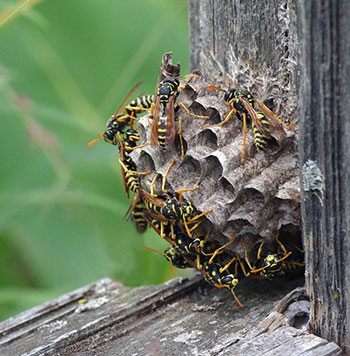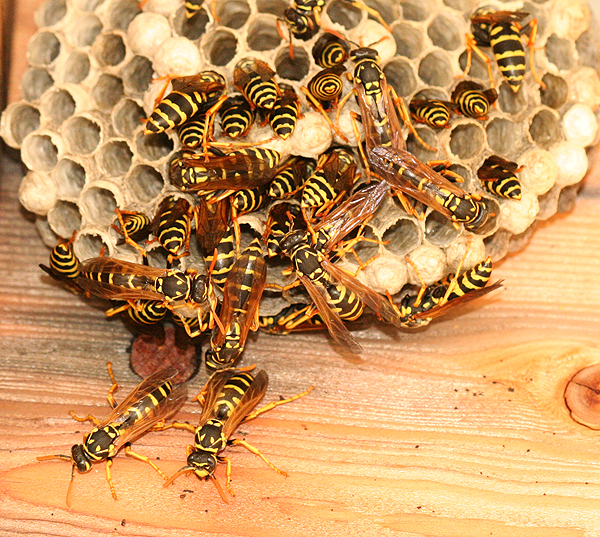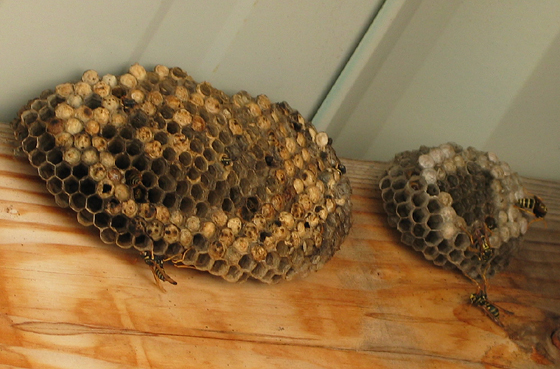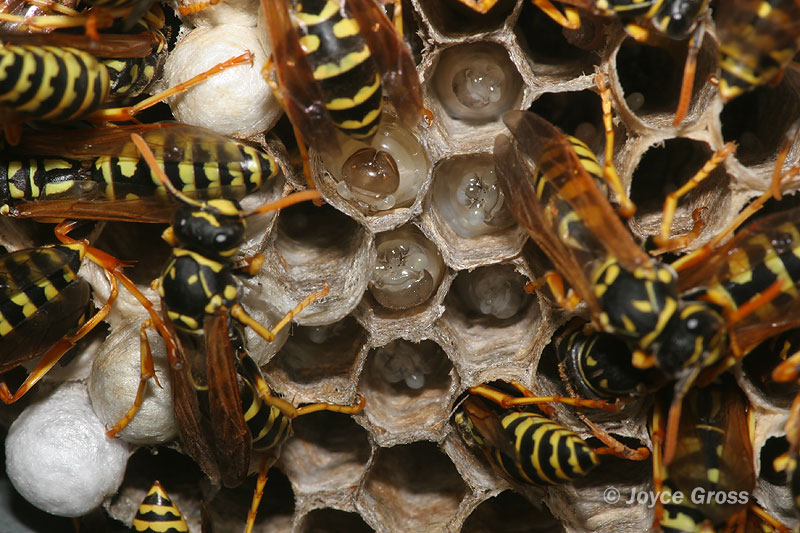Reproduction
Polistes dominula wasps
exhibit a very intricate and complex mating system for being
such small animal. The species use many different signs and
signals, such as chemicals and body coloring, to determine who to
mate with and when. P. dominula are diecious animals
meaning that the organism has separate individuals for the male
and female reproductive organs (Animal Diversity Web 2013).
Female P. dominula wasps are considered iteroparous
because they are able to reproduce more than once in their
lifetime. Copulation between male and female wasps happens
through internal sexual reproduction when a male and female meet
(Animal Diversity Web 2013).
The reproductive cycle for
the P. dominula begins in late summer and early fall.
(Bruschini et al. 2011). During these months between July and
August sexually reproductive males and females emerge from the nests.
P. dominula wasps exhibit a lek system of mating when they get
ready to reproduce. A lek is a group of males that display themselves
on territories to encourage sexual selection (Dastgir et al.
1997). In a lek system of mating male wasp band together to compete and
give females a better opportunity to observe which males possess the
best traits to reproduce with (Dastgir et al. 1997). In this
system male wasps vigorously compete to show dominance and females have
the most choice in whom to mate with (Izzo and Tibbetts 2012, Cappa et
al. 2011). The lek system of reproduction is advantageous to both
male and female wasps. The lek system benefits the male wasp in the
fact that they do not have to waste energy to find a reproductive
partner. It also benefits the female wasps because it allows them to
choice the males that are dominant and possess superior traits that will
be
transferred
to offspring (Dastgir et al. 1997). Sexual reproductive male
P. dominula wasps establish aggregations, also known as
territories, on landmarks near the sight of wasp’s nests (Izzo and Tibbetts
2012, Cappa et al. 2011). Male P. dominula
mark
their territory by wiping their legs and last sternite (a
 component of
the sternum on the ventral portion of the abdomen) on the landmark
(Animal Diversity Web 2013). They often choose structures such as fence
posts, western-facing walls, roof peaks and on the tops of trees when
marking their territory (Izzo and Tibbetts 2012, Encyclopedia of Life
2011). Here males fight for dominance over a territory and usually
happens in mid air or on the territory of a male being challenged (Izzo
and Tibbetts 2012). The males fight by darting, biting or mounting the
other male wasp and the loser of the battle must leave the territory
(Izzo and Tibbetts 2012). Males often sit on their leks for large amounts
of time including weeks and months (Cappa et al. 2013). Females often
fly between the male territories or observe the fighting from perches.
From here they can decide what males are dominant and whom they should
reproduce with (Animal Diversity Web 2013, Izzo and Tibbetts 2012).
component of
the sternum on the ventral portion of the abdomen) on the landmark
(Animal Diversity Web 2013). They often choose structures such as fence
posts, western-facing walls, roof peaks and on the tops of trees when
marking their territory (Izzo and Tibbetts 2012, Encyclopedia of Life
2011). Here males fight for dominance over a territory and usually
happens in mid air or on the territory of a male being challenged (Izzo
and Tibbetts 2012). The males fight by darting, biting or mounting the
other male wasp and the loser of the battle must leave the territory
(Izzo and Tibbetts 2012). Males often sit on their leks for large amounts
of time including weeks and months (Cappa et al. 2013). Females often
fly between the male territories or observe the fighting from perches.
From here they can decide what males are dominant and whom they should
reproduce with (Animal Diversity Web 2013, Izzo and Tibbetts 2012).
In addition to the
lek system of reproduction P. dominula wasps also have chemical
and structural ways of telling whom to mate with. One of the ways that
P. dominula know who to mate with is through the uses of
cuticle hydrocarbons, (CHC) proteins on their bodies. CHC proteins
cover the bodies of P. dominula wasps to provide waterproofing
and protection from parasites and pathogens (Bruschini et al.
2011). CHC proteins more importantly function as a way for the wasps to
tell who is a dominant male or female and whether or not that wasp is
from the same nest (Encyclopedia of Life 2011). For example, CHC
proteins allow male wasps to tell the difference between dominant
females and worker females within a nest. This gives the males a direct
fitness advantage because they are able to copulate with dominant
females that are more likely to produce viable young (Cappa et al.
2013). Although CHC proteins are able to state an individual’s
dominance within a nest they are not able to state their health or
reproductive potential. An example of this being a disadvantage can be
seen when female P. dominula wasps are infected by the Xenos vesparum
parasite. This parasite causes the female wasps to become sterile and
unable to reproduce. The CHC proteins of wasps infected by this
parasite do not change leading males to copulate with females that will
not reproduce (For more on how other organism interact with Polistes
dominula visit the interaction page.)(Cappa et al. 2013).
CHC proteins also play an important role in giving males and females the
ability to identify members from their own nest. P. dominula wasps are
able to identify the CHC proteins on members from their own nests and
therefore avoid copulating with them. Copulating with a member of that
wasp’s own nest is detrimental because it does not allow for genetic
variation or the introduction of new genes (Bruschini et al. 2011).
In addition to the
CHC proteins on wasp’s bodies, P. dominula wasps also exhibit
sexual dimorphism with males differing in size and coloration with
female wasps. This also plays a large role in choosing whom the P.
dominula should mate with. In P. dominula populations, it
has been found that the dorsal abdominal spots on male P. dominula
wasps is a factor that females consider when choosing whom to mate with
(Izzo and Tibbetts 2012, Encyclopedia of Life 2011). It has been found
that male P. dominula wasps that have smaller, more
elliptically shaped spots on their abdomen, often are selected to mate
with more than males wasp that have larger more irregular spots (Izzo
and Tibbetts 2012). Smaller more elliptically shaped spots on a male shows that he is dominant (Izzo and Tibbetts 2012). The female wasps also
display their level of dominance within a nest with differation of
coloration. Female wasps have different colorations on their yellow
clypeus, an area on a wasp’s head just above the mouth. The coloration
of the clypeus is highly variable among female wasps and can differ in
the number, size and shape of the black marks. It has been found that
female wasps that have more black marks on their clypeus are more
dominant within their nests (Encyclopedia of Life 2011).
that he is dominant (Izzo and Tibbetts 2012). The female wasps also
display their level of dominance within a nest with differation of
coloration. Female wasps have different colorations on their yellow
clypeus, an area on a wasp’s head just above the mouth. The coloration
of the clypeus is highly variable among female wasps and can differ in
the number, size and shape of the black marks. It has been found that
female wasps that have more black marks on their clypeus are more
dominant within their nests (Encyclopedia of Life 2011).
Sexual dimorphism is
also displayed in the difference in size of males and females. Females
are often much larger than males and because of this and can choose who
they should mate to have the highest chance of reproducing offspring
(Animal Diversity Web 2013). To do this they often choose the males
that exhibit the greatest dominance through their performance in the lek
mating system and what their CHC proteins and the coloration on their
abdomen express (Encyclopedia of Life 2011, Animal Diversity Web 2013,
Izzo and Tibbetts 2012, Dastgir et al. 1997). In addition, male P.
dominula wasps are also looking to mate with the most dominant and
high-ranking females that they can. Males invest a lot of time and
energy in the mating process. They often protect their territory in a
lek for weeks or months. They also have a limited amount of sperm to
inseminate females with. For this reason males want to mate with the
dominant females from different nest to increase their chances of sexual
fitness (Cappa et al. 2013).
When a female and
male P. dominula wasp finally decided whom to mate with, the
male P. dominula will attempt to copulate with the female (Izzo
and Tibbetts 2012). To copulate with the female, the male mounts the
female by linking his antennae around the female’s antennae and making
genital contact. Because female wasps are larger in size then male
P. dominula wasps, the females are ultimately the ones that choose
who to copulate with (Izzo and Tibbetts 2012).
After the mating
process has been completed, the fertilized queen and females return to
the nest to hibernate
over the winter (Animal Diversity Web 201 3, Penn State Extension 2011).
The they are the only wasps from the nest to survive over the winter
(Animal Diversity Web 2013). Because of an increase in levels of
cryoprotectant, containing raised levels of fructose in their haemolymph
and large stores of lipid within their bodies (Cappa et al.
2013). P. dominula wasps create separate nests in protected
places to hibernate in over the winter. Such as voids in walls or
under tree bark to void the harsh conditions that winters bring (Penn
State Extension 2011). The queen and fertilized females store the sperm
copulated in them by the male wasps in the fall. The stored sperm allow
the queen and fertilized females to lay eggs in the spring (Animal
Diversity Web 2013).
3, Penn State Extension 2011).
The they are the only wasps from the nest to survive over the winter
(Animal Diversity Web 2013). Because of an increase in levels of
cryoprotectant, containing raised levels of fructose in their haemolymph
and large stores of lipid within their bodies (Cappa et al.
2013). P. dominula wasps create separate nests in protected
places to hibernate in over the winter. Such as voids in walls or
under tree bark to void the harsh conditions that winters bring (Penn
State Extension 2011). The queen and fertilized females store the sperm
copulated in them by the male wasps in the fall. The stored sperm allow
the queen and fertilized females to lay eggs in the spring (Animal
Diversity Web 2013).
In March through
April, the queen and fertilized females begin to emerge from hibernation
and start new nests (Bruschuni et al. 2011). This phase of a P.
dominula reproductive cycle is called the pre-emergence phase.
P. dominula often place their nests in protected areas and in man
made structures
 such
as in attics, light poles, wall voids, parking meters and infrequently
used equipment (To learn why they do this, please visit the
interaction page.)(Penn State Extension 2011, Bruschuni et al.
2011). The nests are constructed from wood fibers and paper chewed up
by the wasps (Animal Diversity Web 2013). The nest consists of a
single comb where the young are raised and food is stored (Encyclopedia
of Life 2011). After a nest is established, the fertilized queens and
females will lay their first eggs. The nests contain cells and one egg
goes into each cell (Penn State Extension 2011). The eggs within the
cells will then form a silk cap over the top of their nest cell and
pupate into a larval form within 3 to 5 days of being laid (Animal
Diversity Web 2013). The larvae are creamed color, legless and must
remain in their nest cell until they emerge as adults. The queen and
females then feed the larvae masticated caterpillars and other insects
(Penn State Extension 2011). The larvae turn to adults within 3 to 4
weeks. The first
group of eggs to turn to adults becomes workers subordinate to the queen
(Animal Diversity Web 2013). This group will take over the tasks such
as nest making, gathering food and defending the nest. This allows the
queen to focus on laying more eggs (Animal Diversity Web 2013, Penn
State Extension 2011). In optimal conditions, the process of turning
eggs to adult wasps typically takes around 40 days (Penn State Extension
2011, Animal Diversity Web 2013). This process of egg laying and
transformation to adults will continue all summer until July through
August when reproductive males and females will be released to mate (
Bruschuni et al. 2011, Animal Diversity Web 2013).
such
as in attics, light poles, wall voids, parking meters and infrequently
used equipment (To learn why they do this, please visit the
interaction page.)(Penn State Extension 2011, Bruschuni et al.
2011). The nests are constructed from wood fibers and paper chewed up
by the wasps (Animal Diversity Web 2013). The nest consists of a
single comb where the young are raised and food is stored (Encyclopedia
of Life 2011). After a nest is established, the fertilized queens and
females will lay their first eggs. The nests contain cells and one egg
goes into each cell (Penn State Extension 2011). The eggs within the
cells will then form a silk cap over the top of their nest cell and
pupate into a larval form within 3 to 5 days of being laid (Animal
Diversity Web 2013). The larvae are creamed color, legless and must
remain in their nest cell until they emerge as adults. The queen and
females then feed the larvae masticated caterpillars and other insects
(Penn State Extension 2011). The larvae turn to adults within 3 to 4
weeks. The first
group of eggs to turn to adults becomes workers subordinate to the queen
(Animal Diversity Web 2013). This group will take over the tasks such
as nest making, gathering food and defending the nest. This allows the
queen to focus on laying more eggs (Animal Diversity Web 2013, Penn
State Extension 2011). In optimal conditions, the process of turning
eggs to adult wasps typically takes around 40 days (Penn State Extension
2011, Animal Diversity Web 2013). This process of egg laying and
transformation to adults will continue all summer until July through
August when reproductive males and females will be released to mate (
Bruschuni et al. 2011, Animal Diversity Web 2013).
Continue to Interactions
List of References
HOME
 component of
the sternum on the ventral portion of the abdomen) on the landmark
(Animal Diversity Web 2013). They often choose structures such as fence
posts, western-facing walls, roof peaks and on the tops of trees when
marking their territory (Izzo and Tibbetts 2012, Encyclopedia of Life
2011). Here males fight for dominance over a territory and usually
happens in mid air or on the territory of a male being challenged (Izzo
and Tibbetts 2012). The males fight by darting, biting or mounting the
other male wasp and the loser of the battle must leave the territory
(Izzo and Tibbetts 2012). Males often sit on their leks for large amounts
of time including weeks and months (Cappa et al. 2013). Females often
fly between the male territories or observe the fighting from perches.
From here they can decide what males are dominant and whom they should
reproduce with (Animal Diversity Web 2013, Izzo and Tibbetts 2012).
component of
the sternum on the ventral portion of the abdomen) on the landmark
(Animal Diversity Web 2013). They often choose structures such as fence
posts, western-facing walls, roof peaks and on the tops of trees when
marking their territory (Izzo and Tibbetts 2012, Encyclopedia of Life
2011). Here males fight for dominance over a territory and usually
happens in mid air or on the territory of a male being challenged (Izzo
and Tibbetts 2012). The males fight by darting, biting or mounting the
other male wasp and the loser of the battle must leave the territory
(Izzo and Tibbetts 2012). Males often sit on their leks for large amounts
of time including weeks and months (Cappa et al. 2013). Females often
fly between the male territories or observe the fighting from perches.
From here they can decide what males are dominant and whom they should
reproduce with (Animal Diversity Web 2013, Izzo and Tibbetts 2012). that he is dominant (Izzo and Tibbetts 2012). The female wasps also
display their level of dominance within a nest with differation of
coloration. Female wasps have different colorations on their yellow
clypeus, an area on a wasp’s head just above the mouth. The coloration
of the clypeus is highly variable among female wasps and can differ in
the number, size and shape of the black marks. It has been found that
female wasps that have more black marks on their clypeus are more
dominant within their nests (Encyclopedia of Life 2011).
that he is dominant (Izzo and Tibbetts 2012). The female wasps also
display their level of dominance within a nest with differation of
coloration. Female wasps have different colorations on their yellow
clypeus, an area on a wasp’s head just above the mouth. The coloration
of the clypeus is highly variable among female wasps and can differ in
the number, size and shape of the black marks. It has been found that
female wasps that have more black marks on their clypeus are more
dominant within their nests (Encyclopedia of Life 2011).  3, Penn State Extension 2011).
The they are the only wasps from the nest to survive over the winter
(Animal Diversity Web 2013). Because of an increase in levels of
cryoprotectant, containing raised levels of fructose in their haemolymph
and large stores of lipid within their bodies (Cappa et al.
2013). P. dominula wasps create separate nests in protected
places to hibernate in over the winter. Such as voids in walls or
under tree bark to void the harsh conditions that winters bring (Penn
State Extension 2011). The queen and fertilized females store the sperm
copulated in them by the male wasps in the fall. The stored sperm allow
the queen and fertilized females to lay eggs in the spring (Animal
Diversity Web 2013).
3, Penn State Extension 2011).
The they are the only wasps from the nest to survive over the winter
(Animal Diversity Web 2013). Because of an increase in levels of
cryoprotectant, containing raised levels of fructose in their haemolymph
and large stores of lipid within their bodies (Cappa et al.
2013). P. dominula wasps create separate nests in protected
places to hibernate in over the winter. Such as voids in walls or
under tree bark to void the harsh conditions that winters bring (Penn
State Extension 2011). The queen and fertilized females store the sperm
copulated in them by the male wasps in the fall. The stored sperm allow
the queen and fertilized females to lay eggs in the spring (Animal
Diversity Web 2013).  such
as in attics, light poles, wall voids, parking meters and infrequently
used equipment (To learn why they do this, please visit the
interaction page.)(Penn State Extension 2011, Bruschuni et al.
2011). The nests are constructed from wood fibers and paper chewed up
by the wasps (Animal Diversity Web 2013). The nest consists of a
single comb where the young are raised and food is stored (Encyclopedia
of Life 2011). After a nest is established, the fertilized queens and
females will lay their first eggs. The nests contain cells and one egg
goes into each cell (Penn State Extension 2011). The eggs within the
cells will then form a silk cap over the top of their nest cell and
pupate into a larval form within 3 to 5 days of being laid (Animal
Diversity Web 2013). The larvae are creamed color, legless and must
remain in their nest cell until they emerge as adults. The queen and
females then feed the larvae masticated caterpillars and other insects
(Penn State Extension 2011). The larvae turn to adults within 3 to 4
weeks. The first
group of eggs to turn to adults becomes workers subordinate to the queen
(Animal Diversity Web 2013). This group will take over the tasks such
as nest making, gathering food and defending the nest. This allows the
queen to focus on laying more eggs (Animal Diversity Web 2013, Penn
State Extension 2011). In optimal conditions, the process of turning
eggs to adult wasps typically takes around 40 days (Penn State Extension
2011, Animal Diversity Web 2013). This process of egg laying and
transformation to adults will continue all summer until July through
August when reproductive males and females will be released to mate (
Bruschuni et al. 2011, Animal Diversity Web 2013).
such
as in attics, light poles, wall voids, parking meters and infrequently
used equipment (To learn why they do this, please visit the
interaction page.)(Penn State Extension 2011, Bruschuni et al.
2011). The nests are constructed from wood fibers and paper chewed up
by the wasps (Animal Diversity Web 2013). The nest consists of a
single comb where the young are raised and food is stored (Encyclopedia
of Life 2011). After a nest is established, the fertilized queens and
females will lay their first eggs. The nests contain cells and one egg
goes into each cell (Penn State Extension 2011). The eggs within the
cells will then form a silk cap over the top of their nest cell and
pupate into a larval form within 3 to 5 days of being laid (Animal
Diversity Web 2013). The larvae are creamed color, legless and must
remain in their nest cell until they emerge as adults. The queen and
females then feed the larvae masticated caterpillars and other insects
(Penn State Extension 2011). The larvae turn to adults within 3 to 4
weeks. The first
group of eggs to turn to adults becomes workers subordinate to the queen
(Animal Diversity Web 2013). This group will take over the tasks such
as nest making, gathering food and defending the nest. This allows the
queen to focus on laying more eggs (Animal Diversity Web 2013, Penn
State Extension 2011). In optimal conditions, the process of turning
eggs to adult wasps typically takes around 40 days (Penn State Extension
2011, Animal Diversity Web 2013). This process of egg laying and
transformation to adults will continue all summer until July through
August when reproductive males and females will be released to mate (
Bruschuni et al. 2011, Animal Diversity Web 2013).